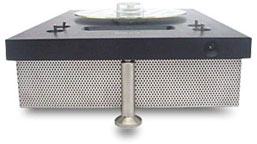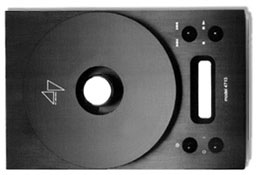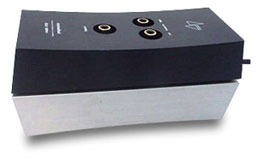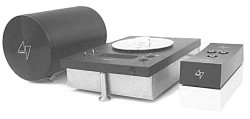![[SoundStage!]](../titles/sslogo3.gif) Home
Audio Home
Audio Equipment Review |
||||||||||||||||||
February 2002 47 Laboratory Model 4713 Flatfish CD Player/Transport, Model 4705 Progression DAC, and 4799 Power Dumpty Power Supplyby Ken Micallef
Think the mainstream, non-audio press ignores us high-end types? I did too until I was recently asked to write an article for a national music magazine profiling four audiophiliacs and their obsessions. The four owned wildly different systems: one used a vinyl-only rig with ancient Quad electrostatics, another went for state-of-the-art solid-state power with Pipedreams speakers, yet another very well-heeled scientific type designed a unique 20.1 surround system that utilized computerized digital modeling and 16 TACT digital power amps as well as a cheap pair of Bose mini pods just to prove his point. The magazine went along for the ride, but the editor rewrote my lead to reflect what they saw as SDD, or Stereo Dysfunctional Disorder. To the argue against that somewhat derogatory, if humorous label, I set out to prove that these audio obsessives were not quacks spending thousands on some Rube Goldberg folly, but intelligent, reasoning adults whose love of music had led them in search of stereo nirvana, not stereo disorder. The abbreviation SDD usefully gauges our audio passion, which originally has its roots in the hobbyist aesthetic. Are we really lunatics to interact so intensely with metal boxes connected by wires? Why do we spend time reading stereo mags online, in the bathroom, in bed, on the train? Do our friends exist only to further our image of our stereo and ourselves with it? Once you accept that the search for sound is an end in itself, that squeezing every final bit of juice out of your stereo is the only way to achieve stereo nirvana, then you can relax. It’s all gonna be OK. You are one who understands the beauty of art, of music, of architecture. Heck, you could probably read Gödel and Escher and even understand them! You know that reaching beauty through sound costs time and money; this can mean spending thousands of dollars for gear or 89 cents for a bicycle-inner-tube tweak. You understand that getting the ultimate in sound replication means getting in there -- this ain’t no disco, this ain’t no fooling around. And if you know these things in your gut, then you are also ready for the fanatics that run Sakura Systems and 47 Lab, manufacturers of the unusual Flatfish CD player/transport, Progression DAC, and big, round Power Humpty, er, Dumpty power supply. Get ready for a cerebellum retrofit; you'll need it to rethink everything you know about high-end audio. The philosophy of Junji 47 Lab is the brainchild of Japanese designer Junji Kimura, who worked for Pioneer, Trio and Kyocera before heading off to reinvent the wheel. Disenchanted with conventional audio, Kimura followed his credo: "Only the simplest can accomplish the most complex." To that end, Kimura designed the Progression DAC with the notion that oversampling and filtering create a smearing, not a clearing, effect. The Progression’s I/V conversion is handled by a passive device rather than an active one. There are only 20 parts in the Progression, and its total signal path is only 35mm -- less than 1 1/2"! Kimura claims its all aluminum chassis "prevents dispersion of digital noise" and the three screws holding it together "reduce the amount of stress on the chassis dramatically." Its curved, Jetsons-worthy design is meant to act as spiked feet on the bottom and to help release vibrations overall. The lack of filtering in the DAC concentrates a wealth of pure energy in the 22kHz region, so you have to be careful with speaker matching. I had no problem with my Revel Performa M20s or the Audio Physic Virgos.
As Wes Phillips noted at onhifi.com, the Progression DAC looks exactly like a Scotch tape dispenser, while the Flatfish (6.5"W by 9.5"D by 2.25"H), looks like a small black box meant for serving sushi. The Flatfish’s upper platform is made of 2/3"-thick, machined aluminum, to which all drive-mechanism parts and circuits are directly mounted. The perforated sheet-metal lower casing gives the Flatfish a ‘50s look, like pleated diner aluminum and tail fins. Kind of. Kimura claims that "compared to the conventional box-type chassis/casings, the [Flatfish’s] platform is almost completely free from any stress of construction." And, "the slight off-centering of the discs allows us to minimize the amount of servo control dramatically." Uh, that CDs spinning off-center also reduce vibration seems to be the gist here. The surprisingly heavy 4799 Power Dumpty ($1800) powers both units via thinly twined cables, which plug into the butt of the Dumpty with a chintzy, clip-on feeling. But the Power Dumpty will take a massive power cord. Amen! All of this quirky, visually provocative gear sitting on your rack could easily fool the significant other. "Hey Hon, what is that? A science project? Are you going DIY again?" Tell her it’s a Japanese clock radio or an ionizer or a modern Jacobs Ladder you bought from Sharper Image, anything to delay the fury she will unleash when she eventually learns of the combined $8,100 price tag. The question is also raised: Who wants to spend this kind of money on digital when Perpetual Technologies and ART have brought the cost of exceptional digital reproduction down to a real Everyman’s budget? The Flatfish has an onboard 4x oversampling 1-bit DAC if you want to start without the Progression, or you can plug in a different DAC. But you have to be careful. There are two outputs (coaxial RCA only) for outboard DACs, one that's DC coupled for the non-filtering Progression (which accepts only coax RCA input) and another that's AC coupled for all the rest. The Progression is so light that a stiff pair of interconnects will set it aloft. But if you weigh it down with the Power Dumpty, it will probably stay put. Kidding! The tin-can-shaped Power Dumpty is no less ergonomically challenged, perched as it is on its slippery aluminum cradle.
47 Lab gear demands total audio immersion and patience. The Flatfish CD player/transport, which weighs 7 pounds, has an orange remote sensor on the front of the unit, but its rather dim digital readout is on top, below where the CD spins. There are four tiny toggle switches: for power, selecting tracks, pause and play, and one marked Stop/TOC. You have to flick the Stop/TOC switch or the Flatfish won’t read the entire CD if the previous CD you played had fewer tracks. For instance, if the previous CD had ten tracks, that is all the Flatfish will recognize on a subsequent disc until you click the switch to identify the contents of the new disc. However, if you Stop/TOC a disc with, say, 20 tracks, you should be covered for most CDs that follow. CDs are held in place by a small acrylic puck that can be easily misplaced. The whole shebang sits on three long spikes that fit into small dimples on the underside of the aluminum platform. This is basically no support at all, but if you run the player without them, the sound quality suffers considerably. I found the entire presentation to be a might persnickety, though the remote (also tiny) offered better programming functionality. Still, all this seemed ultimately aimed for small Tokyo apartments with room screens and immaculate gardens, not big American listening rooms designed around the all-important sweet spot. I stuck the 47 Lab trio on top of a Seismic Sink and forgot about it. Review system My sweet spot is positioned six feet in front of a Blue Circle BC21 preamp with power-supply upgrade, Theta Jade transport connected with JPS Lab Superconductor digital cable to an ART DI/O DAC, Oracle Alexandria Mk II turntable/EAR 834P phono stage/Grado Platinum Reference cartridge combination, Atma-Sphere M-60 Mk II.2 monoblocks, Cardas Golden Reference speaker cables and balanced interconnects with various Shunyata power cords, all running into a Shunyata Hydra power conditioner. Speakers are Revel Performa M20s and Audio Physic Virgos. My rack is a Salamander 5.0, with all manner of Seismic sinks and Sorbothane pucks in use, along with two Blue Circle amp stands. The jaw drops, the buck stops Let me throw the cat out of the bag. The combo of Flatfish, Progression and Power Dumpty is nothing short of sonically sublime. It shows the promise of the CD format fully realized and implemented by a designer who took his own Zen way to find a new digital solution. No matter what I threw at the 47 Lab combo, it consistently sounded beautiful, highly resolving, relaxed and utterly natural. This is how music should sound all the time, thought I. I felt my body relax as I forgot (for the moment) about soundstage and bass weight and transient speed -- I just got into the music. Even with its energy focus in the treble region, I actually thought the 47 Lab combo possessed a slightly dark quality, or perhaps it is the result of my having lived with other lesser DACs for so long. Hearing the full-on, shimmering breadth and deeply tactile nature of the 47 Lab gear stunned me. But even a good friend who owns a Resolution Audio CD player was instantly taken with the 47 Lab combo. Its rightness and natural presentation, which include a wealth of transient detail and very deep organic bass, are impossible to deny. This is beauty stuff. On "Lucy in the Sky with Diamonds" from the recently remastered Yellow Submarine soundtrack [Capitol CDP 7243 5 21481 2 7], I could now hear that McCartney muted his first bass note, while the rest sustain. Lennon’s voice took on even more of a ghostly, surreal quality. Radiohead’s OK Computer [Capitol CDP 7243 805522902], which I always thought was a warmly recorded CD, now sounded cold, detached and distressed, which is fitting given the album’s theme of computer manipulation and human dislocation. The Pat Metheny Group’s Speaking of Now [Warner Bros. 2 48025] is a warm disc, with instruments recorded without effects or studio gimmicks. Here, the relaxed quality of the 47 Lab combo was immensely apparent, revealing tons of nuance and information. Steve Rodby’s bass was deep, with every tactile note wrenching and visceral, as was Antonio Sanchez’s resonant, explosive drumming. The 47 Lab combo plummeted to the depths for full, fat, room-filling bass, but it delivered the full spectrum of the music with sparkle, energy and great vitality. I found myself consistently drawn into the music without noticing the gear, and that's an especially hard nut to crack for the audio critic. This is non-digital digital nirvana for kids at heart. Steely Dan’s Two Against Nature [Giant 24719] is a benchmark recording for me, infused with clever writing and brilliant musicianship. The 47 Lab scanned the disc for every last iota of sound, leaving no digit unturned. I could not only hear the slight bit of reverb on Fagen's voice, but also the swell of guitars interweaving in songs like "Negative Girl" and "What a Shame About Me." Guitarists Becker and Herrington create a lush tapestry that the 47 Lab combo replicated like panes of beautiful stained glass. And throughout, from record to record, the 47 Lab gear defined bass drums with every peculiarity of each drummer. I could feel the weight and slam of beater against head, and the sharply defined edges and placement of the bass drum within the soundstage. But like I said, this was all rendered in a non-analytical way. I'm being analytical here (duh!), but the listening experience was anything but. Even a war-horse like Fritz Reiner’s Pictures at an Exhibition [RCA 09026 61958 2] sounded glorious, with remarkable hall ambience, depth and height. Another benchmark for me is Art of Noise’s The Seduction of Claude Debussy [ZTT/Universal UD 53235], which features in-your-face vocals courtesy of actor John Hurt and some wailing opera diva, as well as rain, thunder and dynamic drum and bass rhythms. The record’s synthetic bass is as low as you will ever hear, and the 47 Lab combo filled the room with its oceanic honey tone and pleasurable sensory overload. Three of a perfect pair As excellent as the 47 Lab digital gear sounds, you cannot mix and match it with anything else and even come close to the synergistic magic it achieves as a trio. Plugging the Progression DAC into my Theta Jade instantly made the music more flat, more edgy, more cold. It lacked the effortless, organic feel of the Progression/Flatfish coupling. The soundstage also shrunk, and I returned to reality -- that is, I came back to earth and all was no longer right in the world. Removing the 47 Lab combo altogether and returning to my Theta/ART DI/O setup caused the music to warm up, and I felt better. Things took on a more natural hue once again, the music began to flow, and the soundstage returned to semi-normalcy. With the amazing leaps in digital of the past year, the ART DI/O is one tiny giant killer, especially with a Monolithic power-supply upgrade, while not approaching in any way the 47 Lab trio. Still, it is an amazing value and to be considered in this frenetic digital era. Which raises the question, even if you have the loot, would you spend this kind of mucho dinero on a pure 16/44 digital format, even one that is as elevated and lofty as the 47 Lab? I, for one, not having heard the Perpetual Technology equipment, would throw down the eight grand needed to purchase such a setup, as it is the most satisfying non-SACD digital experience I have heard. But you also need to consider the bizarre cosmetics and finicky standards the 47 Lab combo will impose on you and your listening habits. Conclusion The 47 Laboratory Model 4713 Flatfish CD player/transport, Model 4705 Progression DAC and 4799 Power Dumpty power supply are a revelation. Power up these honeys and you will search for a way to beg, borrow or steal to own them. As a trio, they make music that is utterly relaxed and non-fatiguing, but full of information -- fast transients, titanic bass, lush midrange -- and nearly perfect tonality. The 47 Lab re-creates the unique personality of each CD, like some wacky sound therapist enabling each CD to find its way to full expression just for you in the privacy of your listening room. It’s you and the musicians -- no stereo, no noisy crowd, no end in sight. 47 Lab has created sonic nirvana in an era of pioneering digital advancements and diminishing returns. (The company offers the $1500 Shigaraki DAC too, but that is perhaps for another review.) Nonetheless, I feel confident in saying that this Zen-inspired combination from Japan may be the last digital purchase you'll make. So much for SDD. ...Ken Micallef
|
||||||||||||||||||
|
||||||||||||||||||
![[SoundStage!]](../titles/sslogo3.gif) All
Contents All
ContentsCopyright © 2002 SoundStage! All Rights Reserved |




